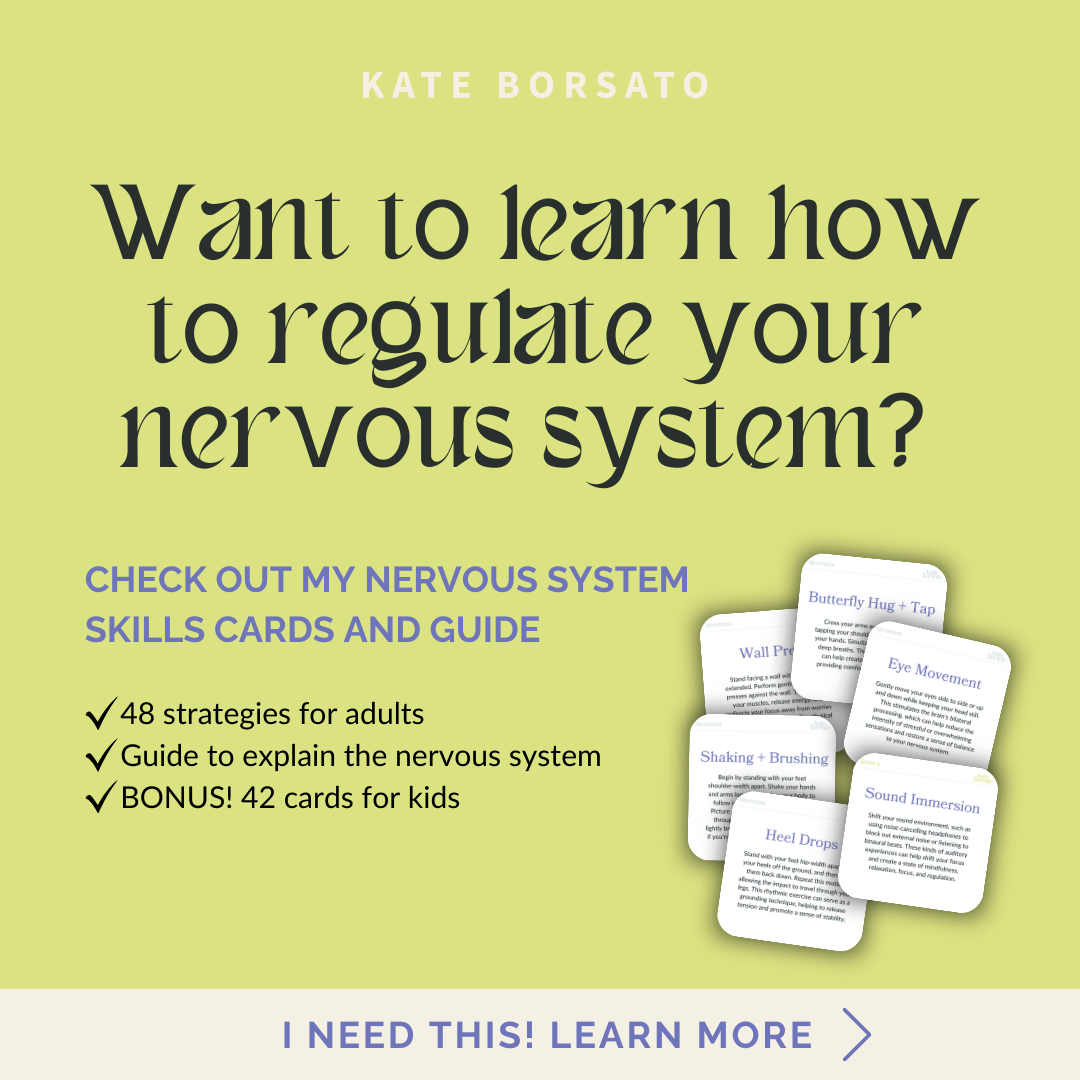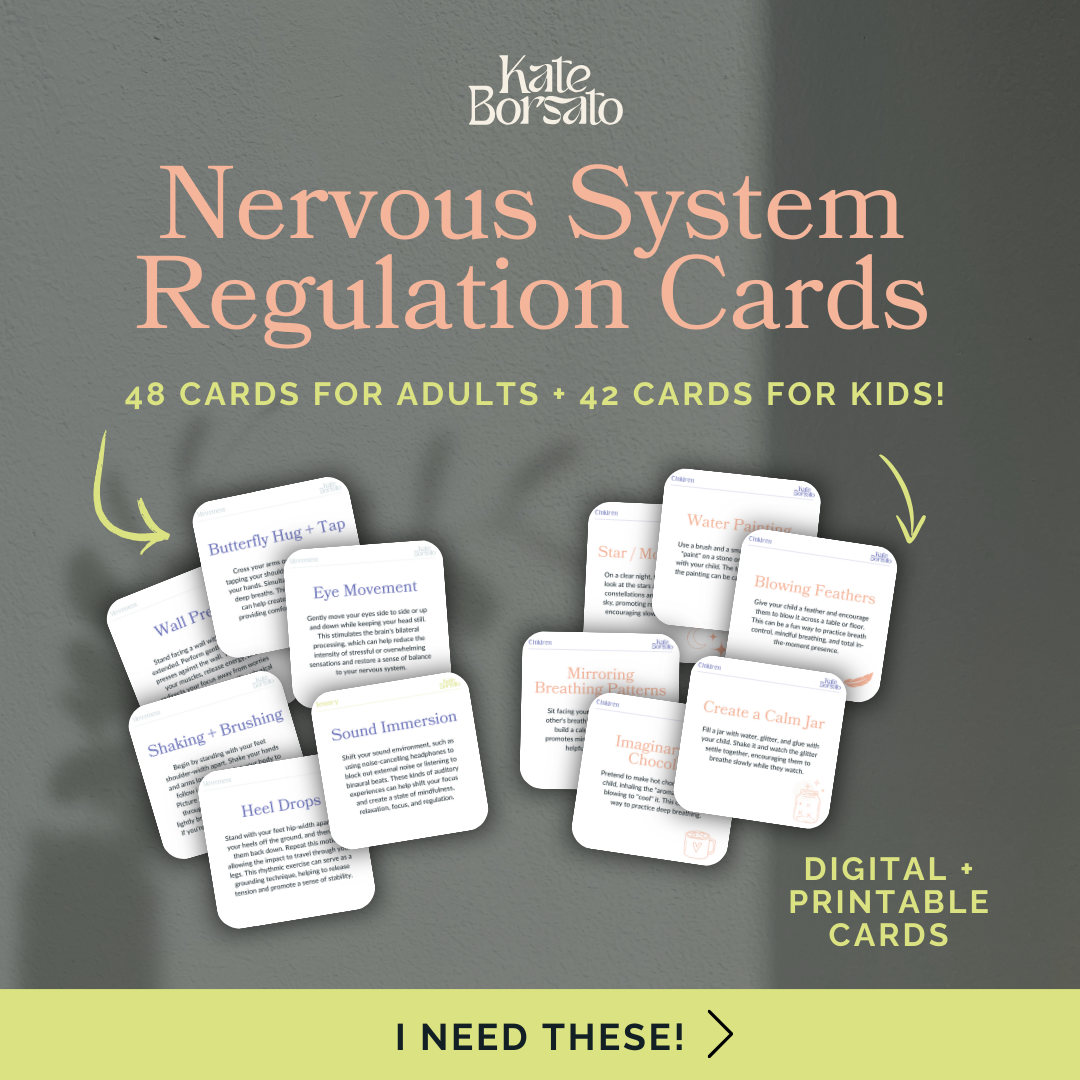When we detect a threat—even if it’s a modern-day stress like pinging notifications or your kids fighting—our nervous system responds.
If you’re someone who has been working on personal growth, wellness, and self development, then by now, much of your social feeds and reading material will mention the nervous system.
You’ve probably heard about nervous system regulation, calming your nervous system, or feeling like your nervous system is out of control. But what does all of that mean? What exactly are we talking about when we mention the nervous system? What is it and why does it matter so much?
I’m going to break down all that in this post because you can’t tend to (or regulate) your nervous system if you’re not even totally sure what it is. Consider this blog post like your nervous system 101.

What is the nervous system?
When I say “fight or flight” mode, does it throw you back to high school science? It does for me! Let me break down why these concepts are still relevant today.
You and your body are primed to constantly assess threats and danger and react accordingly. Think of your nervous system as having this very sensitive internal surveillance scanner that is working 24/7 to scan everything in sight (and sound, feel, etc) to make sure you know about any possible threat coming your way. It takes in a ton of information!
Going a little deeper, essentially the nervous system is like the body’s ultimate communication system. It’s a network made up of cells, tissues, and organs that work together to keep everything in sync. It would sort of be like the main communicator that coordinates and regulates all the body’s functions.
So, what does the nervous system actually do?
Its job is to send messages to parts all over your body. From moving your arm to reach for that top shelf to receiving the warmth of a hug, your nervous system is in charge of all of that. There are lengthy text books all about the nervous system, so we couldn’t possibly get into it all here. But what’s most important for us to understand is that this system is highly connected to mental health, not just physical health. Things like anxiety, depression, burnout, and ADHD, are all highly linked to the nervous system, and when that system is chronically stressed then a person’s mental health usually suffers.
So therefore, we can’t fully address mental health challenges if we don’t look at how the nervous system is functioning.
The Nervous System and Stress
When we’re stressed (either physically, emotionally, or mentally), or when we perceive there to be a threat, our nervous system kicks into gear to help keep us safe. Let me say right up front that the nervous system doesn’t always get it right: there are many times where it will sound the threat alarm for things that are actually not threatening. This is one of the most important takeaways from this post, and a concept that we’ll build on going forward.
Our job is to notice when we go into a threat-response mode, and figure out if it’s necessary or not. And further, to use skills to calm (regulate) the nervous system so you feel safe again. Phew, it’s not exactly an easy skill, I hear you.
But let’s pause that path for now and talk about the 4 ways the nervous system responds to stress (you might remember talking about this in high school): Fight, flight, freeze, and fawn.
The Fight Response
The Fight response refers to the innate physiological and psychological reaction triggered by the nervous system when faced with a perceived threat or danger. Notice that word “perceived” … that means that it’s endless what your unique system could see as a threat. The fight response quite literally preps the body for combat by increasing heart rate, blood pressure, and adrenaline levels. People in this state will feel more aggressive or irritable than usual, with a lot of energy that feels like it needs to come out. This is usually the state moms are in when they feel ragey or uncharacteristically snap at their kids or partners (hey, been there!).
The Flight Response
The Flight response is another automatic reaction to a perceived threat. It activates the body’s “flight” mechanism, which makes a person want to escape or flee from danger (or the thing that’s feeling overwhelming or threatening). In this state, the nervous system will cause your heart rate and breathing to increase so that you could efficiently run away quickly if you needed to. Flight mode also creates the urge to avoid or distance yourself from a situation (or person).
The Freeze Response
The Freeze response is a defense reaction that happens where the body basically becomes immobile and the person might also feel emotionally numb. The freeze response can be looked at as a form of self-preservation, because it attempts to decrease the chance of being noticed by something threatening. People who feel like they shut down easily, get quiet, or “check out” might be experiencing a freeze response.
The Fawn Response
Fawn response, also known as appease or please response, is a safety strategy that the nervous system will activate where the person works hard to seek approval, please others, or avoid conflict, usually by being submissive or compliant. The fawn response leads a person to prioritize the needs and desires of others over their own in an attempt to maintain safety or gain acceptance.
The regulated state of the nervous system
Then there’s also one more really important nervous system response that we can’t skip: the calm state (aka parasympathetic nervous system is active).
This is the state most of us are striving to be in for most of the time, and where we are able to feel our best, and act our best. This is where we want to be when we aren’t actually in danger. That is when you can calmly and clearly think, rationalize, and just… be. If you’re thinking in terms of your day-to-day life, this is when you’re cuddling with your kids or partner, laughing, having a relaxed conversation, engaged in a book, or having dinner with your family. We get to be in this state when we can disarm the threat-detection system and show the nervous system that we are actually safe. This takes a lot of skill and practice! (keep an eye out for more resources on this).
Here’s something I want you to remember as you read through this post: the particular nervous system response that kicks in when you are under stress is automatic, you don’t choose this! Usually the response doesn’t really make sense in the moment either (you’ll question why something feels so threatening when you logically know it’s not such a big deal), and that’s because your nervous system is operating from very old school wiring that still thinks we’re cave people whose survival is in question all the time.
Basically, your drive to survive can hijack your nervous system and cause it to become all out of whack. When we detect a threat—even if it’s a modern-day stress like pinging notifications or your kids fighting—our nervous system responds. Sometimes that response is out of proportion to the threat though. Hence why something like your baby waking up from a nap and starting to cry can often feel like a puma is about to attack! This is just your system trying to protect you… but it doesn’t actually have a positive effect at all.
To make matters worse, motherhood can feel like a constant state of overwhelm and stress where stressors cause your nervous system to become dysregulated all the time. Children screaming, kids’ demands/needs, crying baby, work deadlines, running late for an important appointment, forgetting an important meeting, running your kids to programs, or having an argument with your partner.
The Window Of Tolerance
You might notice that some people seem to be able to stay really calm and regulated, whereas others (maybe you?) seem more likely to lose your cool. Why is that?
There’s something called the Window of Tolerance, where there’s this spectrum or window of the numbers or types of stressors that you can manage before becoming dysregulated or stressed. It’s like the threshold for staying calm, and once you pass that, it’s complete dysregulation.
Not everyone is the same when it comes to the Window of Tolerance. For example, after a particularly difficult season, you may not be able to tolerate the sound of a siren plus two kids arguing at the same time. Your partner, on the other hand, might be able to handle said argument, plus a stream of new emails, a jam-packed day and the stress of a pending deadline. We’re all different, and there are many factors that are at play play when it comes to understanding why your nervous system acts the way it does.
I want to make sure to acknowledge that our upbringing and past experiences have a major role in how the nervous system develops, particularly in situations where a person goes through trauma or very difficult experiences. Look to other posts where I dig deeper into trauma and the nervous system.
This is the 101 of your nervous system, what it does, what it’s supposed to do, and why it can sometimes misread a threat and cause stress. What are ways you notice your nervous system kicking into high gear? When does it become dysregulated? Once you’re more mindful of why this system exists, you can start to tune into when it’s working overtime. Note that anxiety and feeling dysregulated are very similar feelings.
If you’re relating to the idea of your nervous system creating high alerts in your body at every little thing, you may want to find some ways to feel at ease in the moment. For that, check out my post on 15 ways to ease anxiety in less than five minutes.










Comments +